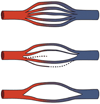A review of string vessels or collapsed, empty basement membrane tubes
- PMID: 20634580
- PMCID: PMC3081641
- DOI: 10.3233/JAD-2010-100219
A review of string vessels or collapsed, empty basement membrane tubes
Abstract
String vessels are thin connective tissue strands, remnants of capillaries, with no endothelial cells; they do not carry blood flow. They occur in numerous species, particularly in the central nervous system, but can occur in any tissue where capillaries have died. String vessels are often associated with pathologies such as Alzheimer's disease, ischemia, and irradiation, but are also found in normal human brains from preterm babies to the aged. They provide a record of the original blood vessel location, but gradually disappear after months or years. There have been numerous studies of string vessels (acellular capillaries) in the retina, because retinal vessels can be seen in great detail in whole mounts after trypsin digestion. Capillary regression occurs by apoptosis, synchronously along capillary segments, with macrophages engulfing apoptotic endothelial cells. Macrophages may cause the apoptosis, or the regression may be triggered by loss of the endothelial cell survival factor VEGF. VEGF expression is induced by hypoxia and promotes capillary growth. Cessation of blood flow eliminates the shear stress that helps maintain endothelial cell survival. Capillaries can re-grow by proliferation and migration of endothelial cells into empty basement membrane tubes, which provide a structural scaffold, replete with signaling molecules. This is a problem in tumor control, but useful for recovery from capillary loss. There is an age-related waning of VEGF expression in response to hypoxia. This causes an age-related decline in cerebral angiogenesis and results in neuronal loss. It may also contribute to the proposed age-related loss of brain reserve.
Figures
References
-
- Cammermeyer J. A comparative study of intervascular connective tissue strands in the central nervous system. J Comp Neurol. 1960;114:189–208. - PubMed
-
- Buée L, Hof PR, Bouras C, Delacourte A, Perl DP, Morrison JH, Fillit HM. Pathological alterations of the cerebral microvasculature in Alzheimer’s disease and related dementing disorders. Acta Neuropathol. 1994;87:469–480. - PubMed
-
- Challa VR, Thore CR, Moody DM, Brown WR, Anstrom JA. A three-dimensional study of brain string vessels using celloidin sections stained with anti-collagen antibodies. J Neurol Sci. 2002;203–204:165–167. - PubMed
-
- Challa VR, Thore CR, Moody DM, Anstrom JA, Brown WR. Increase of white matter string vessels in Alzheimer’s disease. J Alzheimers Dis. 2004;6:379–383. - PubMed
-
- Kalaria RN. The blood-brain barrier and cerebral microcirculation in Alzheimer disease. Cerebrovasc Brain Metab Rev. 1992;4:226–260. - PubMed
Publication types
MeSH terms
Grants and funding
LinkOut - more resources
Full Text Sources
Medical



